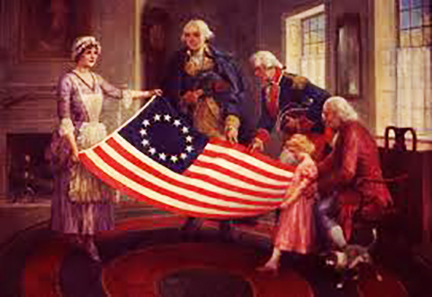
A Flag, A Declaration, and an Anthem
The months of June and July, 1776 were an exciting time for American Patriots. A Quaker lady from the city of Philadelphia, named Elizabeth Claypoole Ross, or Betsy Ross as we know her, would ultimately give two of her three husbands to our newborn nation, as precious sacrifices laid upon the altar of Freedom. She would also give our nation its first flag—one that has inspired citizens and Patriots for over two hundred years now. And just how was that flag born? Well, it’s like this:
In January of that year, George Washington’s troops carried as their standard the Continental Colors: a flag bearing the thirteen colonial stripes with which we are so familiar, and in the canton–the corner of the flag where we now see 50 stars in a blue field–there was a British Union Jack. But clearly, by now the colonies were at war with England, and four major and costly battles had already taken place.
The Union Jack—and all that it represented—had no place on this flag. It was time for those Patriots to adopt a standard that better represented the emergence of an American nation. As tradition holds, Betsy Ross created that new flag with a circular pattern of thirteen five-pointed stars, which were easier for her to cut than the six pointed stars that had been requested.
Meanwhile, as Betsy Ross was finishing that new flag on or about June 14, 1776, and just across town in Philadelphia, a document was being drafted that would be signed on July 4, and immediately read to all of General Washington’s troops and printed in all of the newspapers. It read in part:
When, in the course of human events, it becomes necessary for one people to dissolve the political bands which have connected them with another, and to assume among the powers of the earth, the separate and equal station to which the laws of nature and of nature’s God entitle them, a decent respect to the opinions of mankind requires that they should declare the causes which impel them to the separation.
We hold these truths to be self-evident, that all men are created equal, that they are endowed by their Creator with certain unalienable rights, that among these are life, liberty and the pursuit of happiness. That to secure these rights, governments are instituted among men, deriving their just powers from the consent of the governed. That whenever any form of government becomes destructive to these ends, it is the right of the people to alter or to abolish it, and to institute new government, laying its foundation on such principles and organizing its powers in such form, as to them shall seem most likely to effect their safety and happiness…
These were powerful words!
We, therefore, the representatives of the United States of America, in General Congress, assembled, appealing to the Supreme Judge of the world for the rectitude of our intentions, do, in the name, and by the authority of the good people of these colonies, solemnly publish and declare, that these united colonies are, and of right ought to be free and independent states; that they are absolved from all allegiance to the British Crown, and that all political connection between them and the state of Great Britain, is and ought to be totally dissolved; and that as free and independent states, they have full power to levy war, conclude peace, contract alliances, establish commerce, and to do all other acts and things which independent states may of right do. And for the support of this declaration, with a firm reliance on the protection of Divine Providence, we mutually pledge to each other our lives, our fortunes and our sacred honor.
Signed for Connecticut by: Roger Sherman, Samuel Huntington, William Williams, Oliver Wolcott.
These words, written by men long dead, have protected and sustained countless generations of American citizens down through the ages. And that new flag that those men did behold on July 4, 1776, was the flag that survived shot and shell throughout the American Revolution. And during that span of years it also inspired those defenders of our city, then just a little village known as West Farms, on July 4, 1779, when it was attacked and overrun by two thousand Redcoats.
Francis Scott Key concludes our National Anthem with these lines:
O, thus be it ever when freemen shall stand,
Between their lov’d homes and the war’s desolation;
Blest with vict’ry and peace, may the heav’n-rescued land
Praise the Pow’r that hath made and preserv’d us a nation!
Then conquer we must, when our cause is just,
And this be our motto: “In God is our trust”
And the star-spangled banner in triumph shall wave
O’er the land of the free and the home of the brave!